Qiang Li
Shitz
Bidirectional Mammogram View Translation with Column-Aware and Implicit 3D Conditional Diffusion
Oct 06, 2025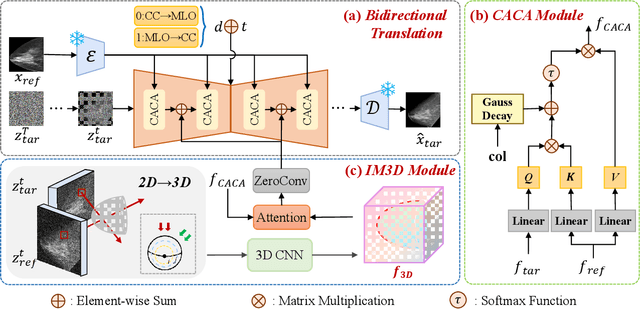
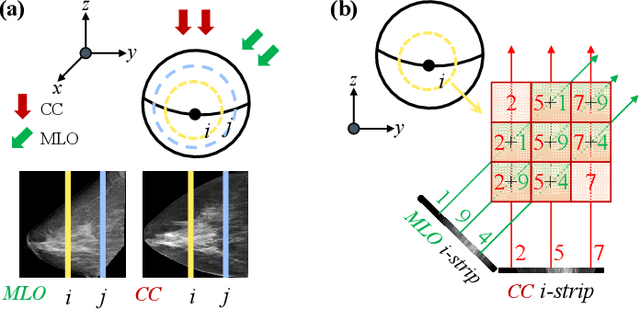
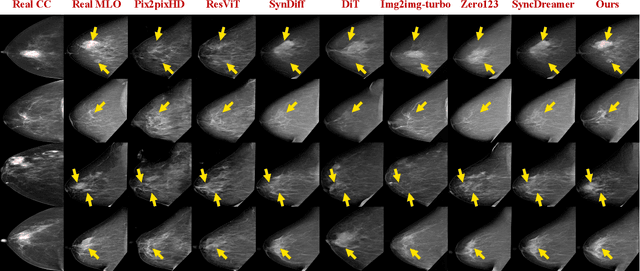
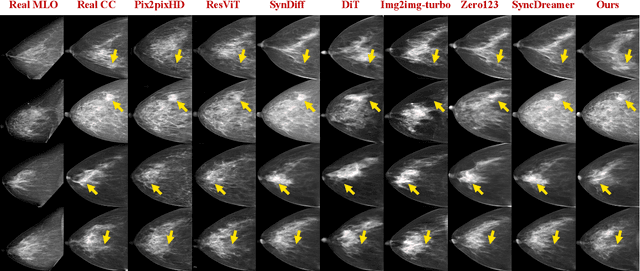
Abstract:Dual-view mammography, including craniocaudal (CC) and mediolateral oblique (MLO) projections, offers complementary anatomical views crucial for breast cancer diagnosis. However, in real-world clinical workflows, one view may be missing, corrupted, or degraded due to acquisition errors or compression artifacts, limiting the effectiveness of downstream analysis. View-to-view translation can help recover missing views and improve lesion alignment. Unlike natural images, this task in mammography is highly challenging due to large non-rigid deformations and severe tissue overlap in X-ray projections, which obscure pixel-level correspondences. In this paper, we propose Column-Aware and Implicit 3D Diffusion (CA3D-Diff), a novel bidirectional mammogram view translation framework based on conditional diffusion model. To address cross-view structural misalignment, we first design a column-aware cross-attention mechanism that leverages the geometric property that anatomically corresponding regions tend to lie in similar column positions across views. A Gaussian-decayed bias is applied to emphasize local column-wise correlations while suppressing distant mismatches. Furthermore, we introduce an implicit 3D structure reconstruction module that back-projects noisy 2D latents into a coarse 3D feature volume based on breast-view projection geometry. The reconstructed 3D structure is refined and injected into the denoising UNet to guide cross-view generation with enhanced anatomical awareness. Extensive experiments demonstrate that CA3D-Diff achieves superior performance in bidirectional tasks, outperforming state-of-the-art methods in visual fidelity and structural consistency. Furthermore, the synthesized views effectively improve single-view malignancy classification in screening settings, demonstrating the practical value of our method in real-world diagnostics.
Terahertz Channel Measurement and Modeling for Short-Range Indoor Environments
Oct 05, 2025Abstract:Accurate channel modeling is essential for realizing the potential of terahertz (THz) communications in 6G indoor networks, where existing models struggle with severe frequency selectivity and multipath effects. We propose a physically grounded Rician fading channel model that jointly incorporates deterministic line-of-sight (LOS) and stochastic non-line-of-sight (NLOS) components, enhanced by frequency-dependent attenuation characterized by optimized exponents alpha and beta. Unlike conventional approaches, our model integrates a two-ray reflection framework to capture standing wave phenomena and employs wideband spectral averaging to mitigate frequency selectivity over bandwidths up to 15 GHz. Empirical measurements at a 208 GHz carrier, spanning 0.1-0.9 m, demonstrate that our model achieves root mean square errors (RMSE) as low as 2.54 dB, outperforming free-space path loss (FSPL) by up to 14.2% and reducing RMSE by 73.3% as bandwidth increases. These findings underscore the importance of bandwidth in suppressing oscillatory artifacts and improving modeling accuracy. Our approach provides a robust foundation for THz system design, supporting reliable indoor wireless personal area networks (WPANs), device-to-device (D2D) communications, and precise localization in future 6G applications.
FreeVPS: Repurposing Training-Free SAM2 for Generalizable Video Polyp Segmentation
Aug 27, 2025Abstract:Existing video polyp segmentation (VPS) paradigms usually struggle to balance between spatiotemporal modeling and domain generalization, limiting their applicability in real clinical scenarios. To embrace this challenge, we recast the VPS task as a track-by-detect paradigm that leverages the spatial contexts captured by the image polyp segmentation (IPS) model while integrating the temporal modeling capabilities of segment anything model 2 (SAM2). However, during long-term polyp tracking in colonoscopy videos, SAM2 suffers from error accumulation, resulting in a snowball effect that compromises segmentation stability. We mitigate this issue by repurposing SAM2 as a video polyp segmenter with two training-free modules. In particular, the intra-association filtering module eliminates spatial inaccuracies originating from the detecting stage, reducing false positives. The inter-association refinement module adaptively updates the memory bank to prevent error propagation over time, enhancing temporal coherence. Both modules work synergistically to stabilize SAM2, achieving cutting-edge performance in both in-domain and out-of-domain scenarios. Furthermore, we demonstrate the robust tracking capabilities of FreeVPS in long-untrimmed colonoscopy videos, underscoring its potential reliable clinical analysis.
DINOv3 with Test-Time Training for Medical Image Registration
Aug 20, 2025Abstract:Prior medical image registration approaches, particularly learning-based methods, often require large amounts of training data, which constrains clinical adoption. To overcome this limitation, we propose a training-free pipeline that relies on a frozen DINOv3 encoder and test-time optimization of the deformation field in feature space. Across two representative benchmarks, the method is accurate and yields regular deformations. On Abdomen MR-CT, it attained the best mean Dice score (DSC) of 0.790 together with the lowest 95th percentile Hausdorff Distance (HD95) of 4.9+-5.0 and the lowest standard deviation of Log-Jacobian (SDLogJ) of 0.08+-0.02. On ACDC cardiac MRI, it improves mean DSC to 0.769 and reduces SDLogJ to 0.11 and HD95 to 4.8, a marked gain over the initial alignment. The results indicate that operating in a compact foundation feature space at test time offers a practical and general solution for clinical registration without additional training.
Capabilities of GPT-5 on Multimodal Medical Reasoning
Aug 13, 2025Abstract:Recent advances in large language models (LLMs) have enabled general-purpose systems to perform increasingly complex domain-specific reasoning without extensive fine-tuning. In the medical domain, decision-making often requires integrating heterogeneous information sources, including patient narratives, structured data, and medical images. This study positions GPT-5 as a generalist multimodal reasoner for medical decision support and systematically evaluates its zero-shot chain-of-thought reasoning performance on both text-based question answering and visual question answering tasks under a unified protocol. We benchmark GPT-5, GPT-5-mini, GPT-5-nano, and GPT-4o-2024-11-20 against standardized splits of MedQA, MedXpertQA (text and multimodal), MMLU medical subsets, USMLE self-assessment exams, and VQA-RAD. Results show that GPT-5 consistently outperforms all baselines, achieving state-of-the-art accuracy across all QA benchmarks and delivering substantial gains in multimodal reasoning. On MedXpertQA MM, GPT-5 improves reasoning and understanding scores by +29.26% and +26.18% over GPT-4o, respectively, and surpasses pre-licensed human experts by +24.23% in reasoning and +29.40% in understanding. In contrast, GPT-4o remains below human expert performance in most dimensions. A representative case study demonstrates GPT-5's ability to integrate visual and textual cues into a coherent diagnostic reasoning chain, recommending appropriate high-stakes interventions. Our results show that, on these controlled multimodal reasoning benchmarks, GPT-5 moves from human-comparable to above human-expert performance. This improvement may substantially inform the design of future clinical decision-support systems.
End-to-end image compression and reconstruction with ultrahigh speed and ultralow energy enabled by opto-electronic computing processor
Jul 30, 2025Abstract:The rapid development of AR/VR, remote sensing, satellite radar, and medical equipment has created an imperative demand for ultra efficient image compression and reconstruction that exceed the capabilities of electronic processors. For the first time, we demonstrate an end to end image compression and reconstruction approach using an optoelectronic computing processor,achieving orders of magnitude higher speed and lower energy consumption than electronic counterparts. At its core is a 32X32 silicon photonic computing chip, which monolithically integrates 32 high speed modulators, 32 detectors, and a programmable photonic matrix core, copackaged with all necessary control electronics (TIA, ADC, DAC, FPGA etc.). Leveraging the photonic matrix core programmability, the processor generates trainable compressive matrices, enabling adjustable image compression ratios (from 2X to 256X) to meet diverse application needs. Deploying a custom lightweight photonic integrated circuit oriented network (LiPICO-Net) enables high quality reconstruction of compressed images. Our approach delivers an end to end latency of only 49.5ps/pixel while consuming only less than 10.6nJ/pixel-both metrics representing 2-3 orders of magnitude improvement compared with classical models running on state-of-the-art GPUs. We validate the system on a 130 million-pixel aerial imagery, enabling real time compression where electronic systems falter due to power and latency constraints. This work not only provides a transformative solution for massive image processing but also opens new avenues for photonic computing applications.
MvHo-IB: Multi-View Higher-Order Information Bottleneck for Brain Disorder Diagnosis
Jul 03, 2025Abstract:Recent evidence suggests that modeling higher-order interactions (HOIs) in functional magnetic resonance imaging (fMRI) data can enhance the diagnostic accuracy of machine learning systems. However, effectively extracting and utilizing HOIs remains a significant challenge. In this work, we propose MvHo-IB, a novel multi-view learning framework that integrates both pairwise interactions and HOIs for diagnostic decision-making, while automatically compressing task-irrelevant redundant information. MvHo-IB introduces several key innovations: (1) a principled method that combines O-information from information theory with a matrix-based Renyi alpha-order entropy estimator to quantify and extract HOIs, (2) a purpose-built Brain3DCNN encoder to effectively utilize these interactions, and (3) a new multi-view learning information bottleneck objective to enhance representation learning. Experiments on three benchmark fMRI datasets demonstrate that MvHo-IB achieves state-of-the-art performance, significantly outperforming previous methods, including recent hypergraph-based techniques. The implementation of MvHo-IB is available at https://github.com/zky04/MvHo-IB.
RTMap: Real-Time Recursive Mapping with Change Detection and Localization
Jul 01, 2025Abstract:While recent online HD mapping methods relieve burdened offline pipelines and solve map freshness, they remain limited by perceptual inaccuracies, occlusion in dense traffic, and an inability to fuse multi-agent observations. We propose RTMap to enhance these single-traversal methods by persistently crowdsourcing a multi-traversal HD map as a self-evolutional memory. On onboard agents, RTMap simultaneously addresses three core challenges in an end-to-end fashion: (1) Uncertainty-aware positional modeling for HD map elements, (2) probabilistic-aware localization w.r.t. the crowdsourced prior-map, and (3) real-time detection for possible road structural changes. Experiments on several public autonomous driving datasets demonstrate our solid performance on both the prior-aided map quality and the localization accuracy, demonstrating our effectiveness of robustly serving downstream prediction and planning modules while gradually improving the accuracy and freshness of the crowdsourced prior-map asynchronously. Our source-code will be made publicly available at https://github.com/CN-ADLab/RTMap (Camera ready version incorporating reviewer suggestions will be updated soon).
SAM4D: Segment Anything in Camera and LiDAR Streams
Jun 26, 2025


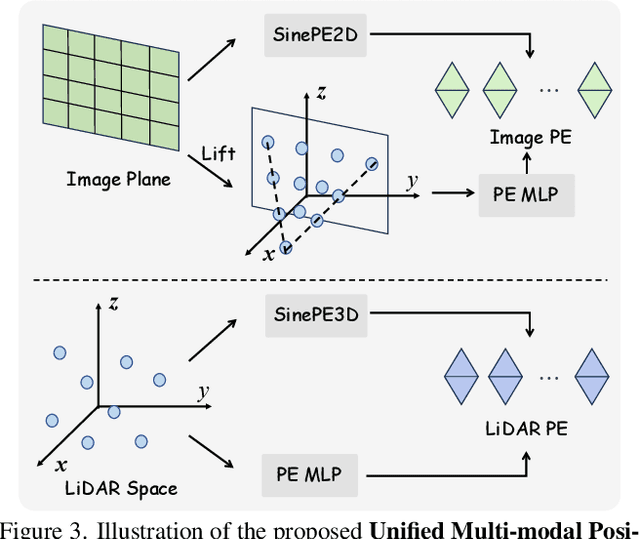
Abstract:We present SAM4D, a multi-modal and temporal foundation model designed for promptable segmentation across camera and LiDAR streams. Unified Multi-modal Positional Encoding (UMPE) is introduced to align camera and LiDAR features in a shared 3D space, enabling seamless cross-modal prompting and interaction. Additionally, we propose Motion-aware Cross-modal Memory Attention (MCMA), which leverages ego-motion compensation to enhance temporal consistency and long-horizon feature retrieval, ensuring robust segmentation across dynamically changing autonomous driving scenes. To avoid annotation bottlenecks, we develop a multi-modal automated data engine that synergizes VFM-driven video masklets, spatiotemporal 4D reconstruction, and cross-modal masklet fusion. This framework generates camera-LiDAR aligned pseudo-labels at a speed orders of magnitude faster than human annotation while preserving VFM-derived semantic fidelity in point cloud representations. We conduct extensive experiments on the constructed Waymo-4DSeg, which demonstrate the powerful cross-modal segmentation ability and great potential in data annotation of proposed SAM4D.
Robotic Perception with a Large Tactile-Vision-Language Model for Physical Property Inference
Jun 24, 2025Abstract:Inferring physical properties can significantly enhance robotic manipulation by enabling robots to handle objects safely and efficiently through adaptive grasping strategies. Previous approaches have typically relied on either tactile or visual data, limiting their ability to fully capture properties. We introduce a novel cross-modal perception framework that integrates visual observations with tactile representations within a multimodal vision-language model. Our physical reasoning framework, which employs a hierarchical feature alignment mechanism and a refined prompting strategy, enables our model to make property-specific predictions that strongly correlate with ground-truth measurements. Evaluated on 35 diverse objects, our approach outperforms existing baselines and demonstrates strong zero-shot generalization. Keywords: tactile perception, visual-tactile fusion, physical property inference, multimodal integration, robot perception
 Add to Chrome
Add to Chrome Add to Firefox
Add to Firefox Add to Edge
Add to Edge